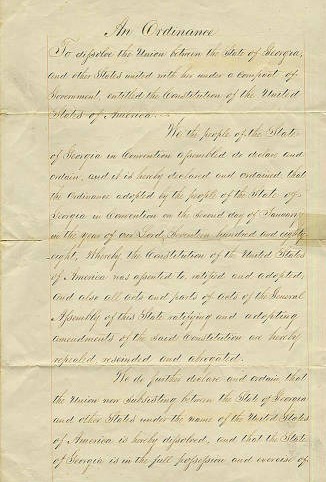Georgia Ordinance of Secession
Georgia’s decision to secede from the Union is widely seen as a turning point in the state’s history. It caused tremendous chaos within the state itself. It was ultimately an event that assisted in speeding up the movement to abolish slavery. The topic of secession had been long debated in Georgia before it actually happened. After the presidential election of the anti-slavery activist Abraham Lincoln, it seemed inevitable. Lincoln’s win in the presidential election instilled fear in many of the white plantation holders with many slaves, whereas it sparked hope in the hearts of many slaves. The Georgia Secession Convention was held in Milledgeville on January 16, 1961. Immediate secessionists held a majority, and it was decided that Georgia would secede from the Union. Georgia officially seceded from the Union on January 19, 1961. Now that Georgia had broken away from the rest of the nation, it was seen as a rebel state. Therefore, Georgia became an immediate target for many Union forces. This act sparked hope in many of the slaves as it was the first step in their journey to embark freedom. This decision influenced many of the slaves to rebel and increased hope in the abolitionists, as well. Certain acts of rebellion involved breaking tools used for work, setting fire to buildings, faking illness and slowing down work. Georgia’s decision to secede from the Union hastened the Civil War and marked the beginning of the end for Confederate Georgia. This had ultimately led to the banishment of the practice of slavery.
